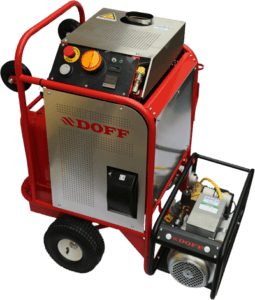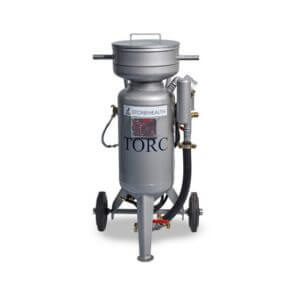Just like cleaning natural stone, there are many considerations to take into account before commencing any cleaning to brickwork and terracotta.
Both brick and terracotta are fired clay, but they each have different properties. This means that they also have different sensitivities to cleaning, including the pressure they can withstand and the dilution of any chemicals used.
A Thorough Understanding
Perhaps the most important factor to think about is ensuring a full understanding of the materials used, how they react with the dirt on them and how they may react once said dirt is removed.
It is also important to consider the mortar that has been used, too. Traditional brickwork mortars were based on soft mixes of lime and sand, meaning that they can actually be softer than the bricks themselves. If the mortar isn’t considered, and it is treated harshly, it could suffer severely from unexpected damage.
The amount of weathering present, and its effects, is also a vital part of understanding the material.
Cleaning Established Brickwork
The biggest problem with cleaning established brickwork is that atmospheric soiling is not water-soluble. This means that something else usually has to be used alongside the water for it to be effective, such as a form of abrasion or a chemical.
Although abrasive cleaning is usually best avoided as it can cause frequent and severe damage, cleaning can be effective and non-damaging providing there’s a sufficient understanding.
Different pressures and abrasives can also have differing results on bricks depending on their thickness and texture.
Any chemicals used on established brickwork should be low-strength and applied neatly. Once left to sit for a short duration, they should be thoroughly rinsed at low pressures to ensure control of flow.
The porosity of the brick also needs to be taken into account. A more porous brick will have a higher absorbency which can affect, or even define, the parameters of chemical use.
Cleaning Terracotta
Architectural Terracotta became fashionable in England during the 1860’s and much of it remains today. It is one of the easiest traditional masonry materials to damage by incorrect cleaning.
As with brickwork, the soiling commonly found on terracotta is not water-soluble. And for both glazed and unglazed terracotta, the surfaces usually soil in areas with the heaviest water saturation, particularly the areas closest to the mortar joints.
Serious damage can be caused by incorrect cleaning, particularly when using abrasive cleaning, acid and/or alkaline cleaning and any form of mechanical cleaning. Chemical cleaning can be successful when used at the right consistency, concentration, and for the right dwell times.
Although the soiling on terracotta is generally an intense black, the layer is usually pretty thin, albeit difficult and stubborn to remove.
Why Do I Need A Professional Clean?
Some of the more common reasons for carrying out a clean include:
- To improve appearance
- To remove impervious paintwork
- To help blend in original brickwork or terracotta with new eg. following an extension or extensive repairs
- To slow down damage and decay due to deposits such as lichen and algae on the surface
- To help reveal the condition of the building so that cracks, missing pointing and other structural issues are more easily identified
- To allow the repair of structural issues such as cracks and missing pointing. The decision to clean and how to clean will largely depend on the materials present and the level of soiling.
Safe and Effective Cleaning Techniques
There are safe and effective ways to clean both brickwork and terracotta without risking damage to the underlying surface. At Ideal Response, we utilise the DOFF and TORC systems by Stonehealth.
Both of these systems make use of low-pressure water and avoid damage to the underlying surface.
DOFF

DOFF is a steam based cleaning system that can reach temperatures up to 150°C at the nozzle end, making it a “superheated water system”. Not only can the operator control the pressure, they can also control the temperature, meaning that they can adjust as necessary depending on the type of soiling and the material of the surface being cleaned.
The pressure used is kept to a gentle flow and the volume of water that passes through the system is kept between 3 – 5 litres per minute. This ensures that the surface is not saturated and that the affected materials usually dry within a matter of minutes.
Ultimately, the surface being cleaned receives no damaging pressure, thermal shock or deep saturation.
DOFF cleaning is highly effective at removing moss, algae, fungi and other biological matters and it also kills spores. This means that there’s no need to use chemicals during the cleaning process.
TORC

Designed exclusively for Stonehealth, TORC is a complete cleaning system that boasts a variety of different nozzles to complement the size of the area being cleaned.
A swirling vortex is created using a mix of low air pressure, a low volume of water and a safe inert fine granulate.
Because water volume is kept to a maximum of 60 litres per hour, the risk of impact damage is avoided. The TORC system is not a blasting system; it benefits from sensitive controls which means that the operator has full control.
The TORC system produces results that are probably the most sensitive and efficient for cleaning masonry.
Why Ideal Response?
Ideal Response are accredited by Stonehealth and as members of The Society for the Protection of Ancient Buildings, we have helped with the restoration of some of the UK’s most precious architecture. Our senior managers have a wealth of experience, gained through the delivery of many varied stone cleaning and restoration projects.



